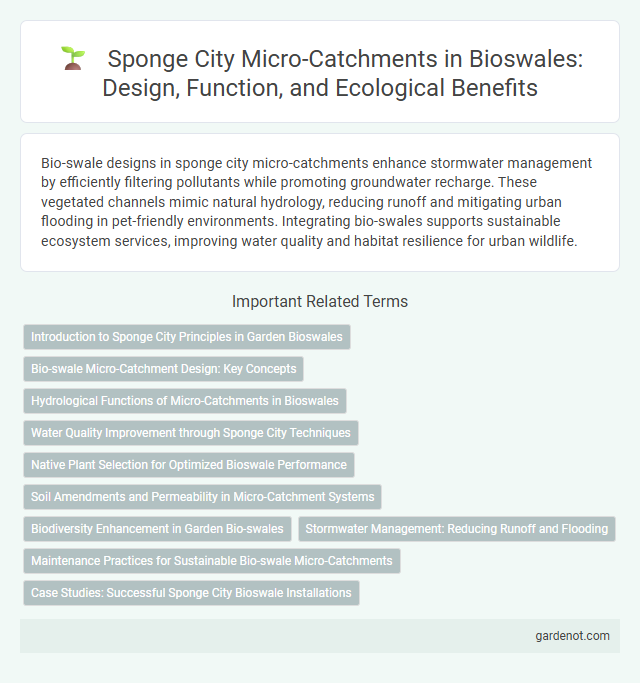Bio-swale designs in sponge city micro-catchments enhance stormwater management by efficiently filtering pollutants while promoting groundwater recharge. These vegetated channels mimic natural hydrology, reducing runoff and mitigating urban flooding in pet-friendly environments. Integrating bio-swales supports sustainable ecosystem services, improving water quality and habitat resilience for urban wildlife.
Introduction to Sponge City Principles in Garden Bioswales
Garden bioswales incorporate sponge city principles by enhancing urban water management through natural infiltration and retention techniques. These micro-catchments capture stormwater runoff, reducing flooding while promoting groundwater recharge and improving water quality. Vegetated swales trap pollutants and sediments, supporting sustainable, resilient urban landscapes that mimic natural hydrological cycles.
Bio-swale Micro-Catchment Design: Key Concepts
Bio-swale micro-catchment design incorporates permeable vegetation beds and engineered soil media to maximize stormwater infiltration and pollutant removal. Key concepts include optimizing flow paths to enhance retention time and incorporating native plant species that promote evapotranspiration while stabilizing soil. Integrating bio-swales within sponge city frameworks supports decentralized water management and mitigates urban flooding by mimicking natural hydrological processes.
Hydrological Functions of Micro-Catchments in Bioswales
Micro-catchments in bioswales significantly enhance urban hydrological functions by promoting infiltration, reducing surface runoff, and facilitating groundwater recharge. These engineered landscapes capture and treat stormwater, mitigating flood risks and improving water quality through sedimentation and pollutant filtration. Optimizing micro-catchment design supports sustainable urban drainage systems, contributing to resilient sponge city infrastructure.
Water Quality Improvement through Sponge City Techniques
Sponge city micro-catchments use bio-swales to enhance water quality by effectively filtering pollutants and reducing surface runoff. These eco-friendly landscapes slow down stormwater, promoting infiltration and natural purification of contaminants such as sediments, heavy metals, and nutrients. Integrating bio-swales within sponge city infrastructures supports sustainable urban water management and improves local aquatic ecosystems.
Native Plant Selection for Optimized Bioswale Performance
Native plant selection is critical for optimizing bioswale performance in sponge city micro-catchments, enhancing stormwater absorption and pollutant removal. Deep-rooted native species improve soil infiltration rates and stabilize soil structure, reducing runoff and erosion. Selecting drought-tolerant and pollution-resistant native plants promotes sustainable bioswale function under varying urban conditions.
Soil Amendments and Permeability in Micro-Catchment Systems
Soil amendments in sponge city micro-catchments enhance permeability by improving soil structure and increasing organic matter content, which facilitates better water infiltration and retention. Incorporating biochar, compost, and other organic materials optimizes micro-catchment systems by promoting microbial activity and nutrient cycling, essential for sustainable stormwater management. Improved soil permeability reduces surface runoff, mitigates flooding risks, and supports groundwater recharge within urban bio-swale applications.
Biodiversity Enhancement in Garden Bio-swales
Garden bio-swales in sponge city micro-catchments play a crucial role in enhancing urban biodiversity by providing habitat diversity and supporting native plant species. These bioswales facilitate natural water filtration and create microhabitats for pollinators, amphibians, and soil microorganisms, boosting ecosystem resilience. Integrating diverse vegetation and structural complexity in bio-swales improves ecological connectivity and urban green space multifunctionality.
Stormwater Management: Reducing Runoff and Flooding
Bio-swales in sponge city micro-catchments effectively capture and infiltrate stormwater, significantly reducing surface runoff and mitigating urban flooding risks. These vegetated channels enhance soil permeability and promote groundwater recharge, improving overall stormwater management efficiency. Integrating bio-swales supports sustainable urban drainage systems, minimizing flood damage and enhancing water quality by filtering pollutants.
Maintenance Practices for Sustainable Bio-swale Micro-Catchments
Maintenance practices for sustainable bio-swale micro-catchments in sponge cities include regular inspection and removal of sediment, debris, and invasive vegetation to ensure optimal infiltration and pollutant removal. Adaptive management strategies involve monitoring hydrologic performance and soil moisture levels to maintain healthy plant growth and prevent clogging. Employing native vegetation and periodic soil amendments enhances long-term resilience and ecological functionality.
Case Studies: Successful Sponge City Bioswale Installations
Sponge city micro-catchments utilize bioswales to effectively manage stormwater by mimicking natural hydrological processes, as demonstrated in successful installations in cities like Wuhan and Beijing. These bioswales capture runoff, filter pollutants, and recharge groundwater, significantly reducing urban flooding and improving water quality. Case studies highlight the integration of native vegetation and permeable soils, which enhance infiltration rates and biodiversity within densely populated urban environments.
Sponge city micro-catchment Infographic

 gardenot.com
gardenot.com